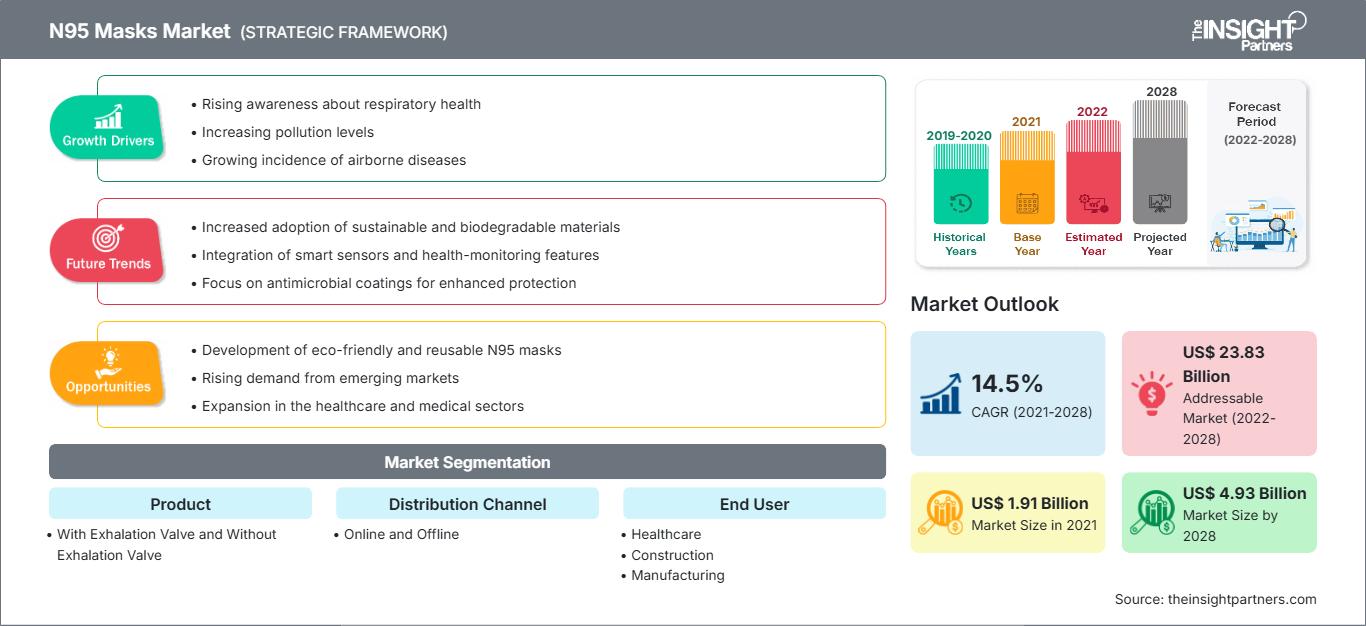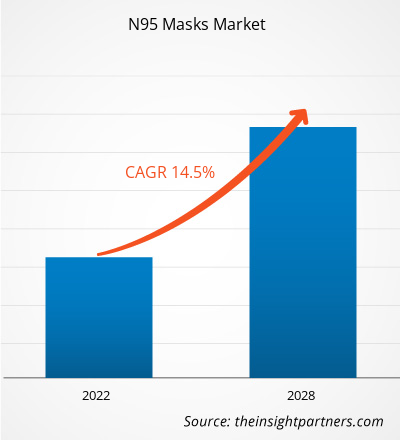Se proyecta que el mercado de mascarillas N95 alcance los US$ 4.925,80 millones para 2028 desde los US$ 1.914,54 millones en 2021; se espera que registre una CAGR del 14,5% entre 2021 y 2028.
Las mascarillas faciales son un tipo particular de equipo de protección personal diseñado para reducir la exposición respiratoria del usuario a sustancias peligrosas, como sustancias químicas tóxicas o partículas infecciosas. Las mascarillas N95 son capaces de bloquear al menos el 95 % de las partículas suspendidas en el aire mayor de 2,5 micras, incluyendo partículas o gotitas portadoras de virus y bacterias, protegiendo así a las personas contra infecciones y enfermedades de las vías respiratorias.
El informe ofrece información y un análisis profundo del mercado de mascarillas N95, con énfasis en diversos parámetros como las tendencias, los avances tecnológicos, la dinámica del mercado y el análisis del panorama competitivo de los principales actores del mercado a nivel mundial. También incluye el impacto de la pandemia de COVID-19 en el mercado en todas las regiones. La demanda de mascarillas N95 en las regiones ha aumentado significativamente durante la pandemia. Para abordar la escasez, agencias reguladoras como la FDA de los Estados Unidos (USFDA) han revisado las directrices sobre los EPI. La agencia ha liberalizado los procedimientos de aprobación de productos para facilitar su rápida disponibilidad en el mercado. Diversos actores del mercado, no relacionados con el sector sanitario, participan en la producción de batas hospitalarias para satisfacer la alta demanda. Las empresas existentes están intensificando la producción y la cadena de suministro de batas hospitalarias en la región. Sin embargo, en la situación actual, se están comercializando varias mascarillas N95 falsificadas de empresas de marca. El gobierno ha emitido una alerta al respecto. Por ejemplo, Health Canada emitió una advertencia sobre respiradores/mascarillas 3M N95 falsificadas. La COVID-19 ha tenido un impacto positivo en el mercado de mascarillas N95 en la región. Este mercado está segmentado por producto, canal de distribución, usuario final y región. El mercado, según la región, se divide en Norteamérica, Europa, Asia Pacífico, Oriente Medio y África, y Sudamérica y Centroamérica.
Personalice este informe según sus necesidades
Obtendrá personalización en cualquier informe, sin cargo, incluidas partes de este informe o análisis a nivel de país, paquete de datos de Excel, así como también grandes ofertas y descuentos para empresas emergentes y universidades.
Mercado de mascarillas N95: Perspectivas estratégicas

- Obtenga las principales tendencias clave del mercado de este informe.Esta muestra GRATUITA incluye análisis de datos, desde tendencias del mercado hasta estimaciones y pronósticos.
Perspectivas del mercado
Prevalencia de COVID-19
La COVID-19 es una enfermedad contagiosa que se transmite por la nariz y la boca. Desde su aparición, el SARS-CoV-2, su agente causal, ha mutado en varias ocasiones, lo que ha agravado la pandemia. Desde las primeras fases de esta crisis, la Organización Mundial de la Salud (OMS), así como las autoridades sanitarias de numerosos países, han instruido a los profesionales sanitarios y al público en general sobre el uso de mascarillas faciales que reduzcan las posibilidades de transmisión del virus de personas infectadas o portadoras a la población sana. Por ello, la demanda de mascarillas ha aumentado exponencialmente desde 2020. Los gobiernos y los organismos reguladores insisten en el uso continuo de mascarillas en espacios públicos. Como resultado, la demanda de mascarillas N95 también ha aumentado. Según los datos del sistema de seguimiento de COVID-19 de los Centros para el Control y la Prevención de Enfermedades (CDC), al 17 de agosto de 2021, la tasa de casos por cada 100.000 habitantes en siete días era de 270,6, y se habían notificado más de 113.993 casos nuevos en EE. UU. Además, según el Centro Europeo para la Prevención y el Control de Enfermedades, al 12 de agosto de 2021, el recuento total de casos de COVID-19 en el Espacio Económico Europeo (EEE) ascendía a aproximadamente 35.381.520.
Perspectivas basadas en productos
Según el producto, el mercado de mascarillas N95 se segmenta en mascarillas sin válvula de exhalación y mascarillas con válvula de exhalación. En 2021, se estima que el segmento sin válvula de exhalación representará una mayor cuota de mercado, mientras que se espera que el segmento con válvula de exhalación registre una mayor tasa de crecimiento anual compuesta (TCAC) durante el período de pronóstico. El crecimiento de este segmento se atribuye a la alta eficiencia de la protección que proporciona durante la inhalación y la exhalación. Diversos organismos gubernamentales, como la OMS, los CDC y los ministerios de salud de varios países, están fomentando el uso de estas mascarillas para prevenir la propagación del virus de una persona infectada.
Información basada en canales de distribución
Según el canal de distribución, el mercado de mascarillas N95 se segmenta en presencial y en línea. El segmento presencial tendría una mayor participación en 2021. Sin embargo, se estima que el segmento en línea registrará una mayor tasa de crecimiento anual compuesta (TCAC) durante el período de pronóstico.
Información basada en el usuario final
Según el usuario final, el mercado de mascarillas N95 se segmenta en construcción, manufactura, salud, minería, petróleo y gas, entre otros. El segmento de la construcción representaría la mayor participación del mercado en 2021, mientras que se estima que el segmento de la salud registrará la mayor tasa de crecimiento anual compuesta (TCAC) durante el período de pronóstico.
Los actores del mercado de mascarillas N95 adoptan estrategias orgánicas como el lanzamiento y la expansión de productos para expandir su presencia y cartera de productos en todo el mundo, así como para satisfacer la creciente demanda.
Análisis regional del mercado de mascarillas N95
Los analistas de The Insight Partners han explicado detalladamente las tendencias regionales y los factores que influyen en el mercado de mascarillas N95 durante el período de pronóstico. Esta sección también analiza los segmentos y la geografía del mercado de mascarillas N95 en Norteamérica, Europa, Asia Pacífico, Oriente Medio y África, y Sudamérica y Centroamérica.
Alcance del informe de mercado de mascarillas N95
| Atributo del informe | Detalles |
|---|---|
| Tamaño del mercado en 2021 | 1.910 millones de dólares estadounidenses |
| Tamaño del mercado en 2028 | US$ 4,93 mil millones |
| Tasa de crecimiento anual compuesta (TCAC) global (2021-2028) | 14,5% |
| Datos históricos | 2019-2020 |
| Período de pronóstico | 2022-2028 |
| Segmentos cubiertos | Por producto
|
| Regiones y países cubiertos | América del Norte
|
| Líderes del mercado y perfiles de empresas clave |
|
Densidad de actores del mercado de mascarillas N95: comprensión de su impacto en la dinámica empresarial
El mercado de mascarillas N95 está creciendo rápidamente, impulsado por la creciente demanda del usuario final debido a factores como la evolución de las preferencias de los consumidores, los avances tecnológicos y un mayor conocimiento de los beneficios del producto. A medida que aumenta la demanda, las empresas amplían su oferta, innovan para satisfacer las necesidades de los consumidores y aprovechan las tendencias emergentes, lo que impulsa aún más el crecimiento del mercado.

- Obtenga una descripción general de los principales actores clave del mercado de mascarillas N95
Por producto
- Sin válvula de exhalación
- Con válvula de exhalación
Por canal de distribución
- Desconectado
- En línea
Por el usuario final
- Construcción
- Fabricación
- Cuidado de la salud
- Minería, petróleo y gas
- Otros
Por
Geografía
- América del Norte
- A NOSOTROS
- Canadá
- México
- Europa
- Francia
- Alemania
- Italia
- Reino Unido
- España
- Resto de Europa
- Asia Pacífico (APAC)
- Porcelana
- India
- Corea del Sur
- Japón
- Australia
- Resto de APAC
- Oriente Medio y África (MEA)
- Sudáfrica
- Arabia Saudita
- Emiratos Árabes Unidos
- Resto de MEA
- América del Sur y Central (SCAM)
- Brasil
- Argentina
- Resto de ESTAFA
Perfiles de empresas
- 3M
- Corporación Kimberly-Clark
- Industrias Medline, Inc.
- Cardinal Health Inc
- Ansell Limitada
- ALPHA PRO TECH, LTD.
- Honeywell International Inc.
- La Compañía Gerson
- Medisca Inc
- Moldex-Métrico
- Análisis histórico (2 años), año base, pronóstico (7 años) con CAGR
- Análisis PEST y FODA
- Tamaño del mercado, valor/volumen: global, regional y nacional
- Industria y panorama competitivo
- Conjunto de datos de Excel
Informes recientes
Testimonios
Razón para comprar
- Toma de decisiones informada
- Comprensión de la dinámica del mercado
- Análisis competitivo
- Información sobre clientes
- Pronósticos del mercado
- Mitigación de riesgos
- Planificación estratégica
- Justificación de la inversión
- Identificación de mercados emergentes
- Mejora de las estrategias de marketing
- Impulso de la eficiencia operativa
- Alineación con las tendencias regulatorias




















 Obtenga una muestra gratuita para - Mercado de mascarillas N95
Obtenga una muestra gratuita para - Mercado de mascarillas N95